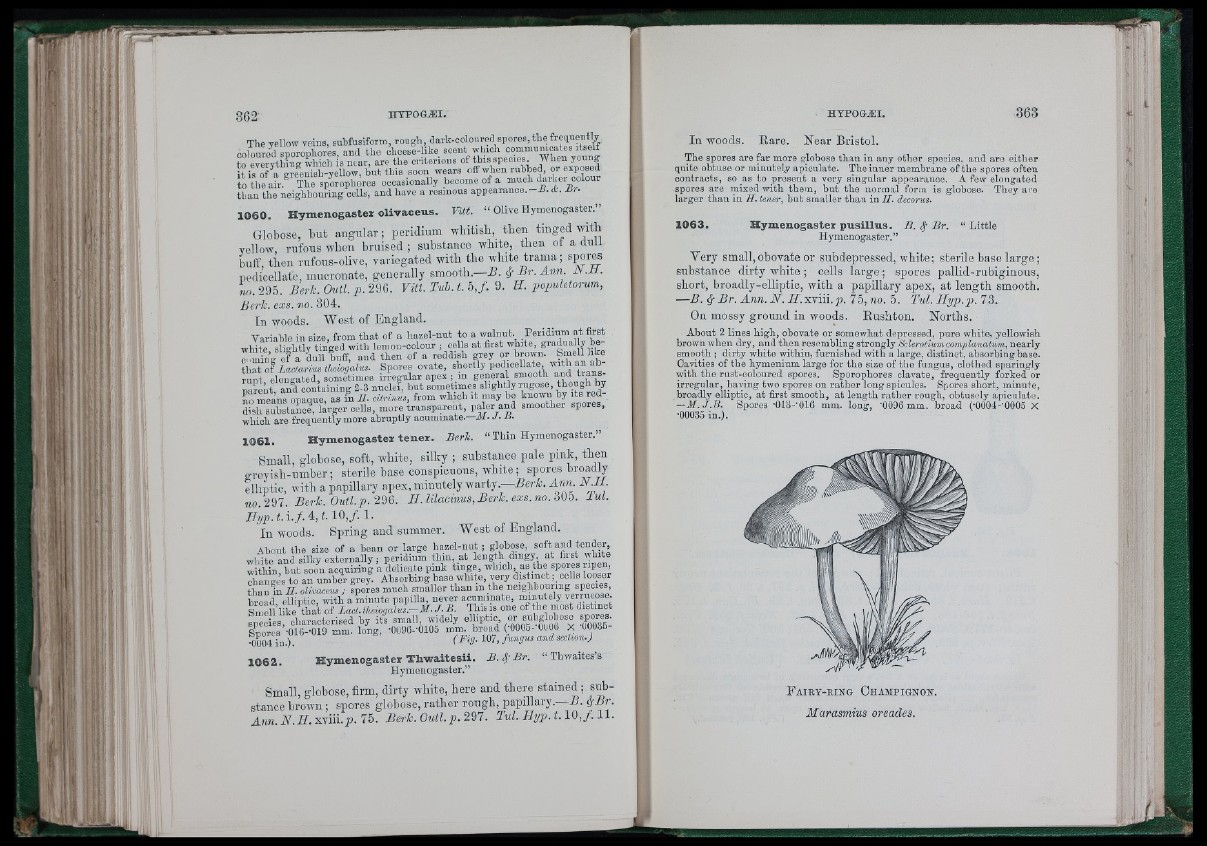
I' ‘
: I i I:",
, H J ■'
The yellow veins, snbfusifonn, rough, dark-coloured spores, the frequently
coloure!a sporophor’es, and the cheese-like scent which
to everythteg which is near, are the criterions of
it is of a greenish-yellow, bnt this soon wears off when ru b b e / or «»ipore“
to the air. The sporophores occasionally become of a much^darker colon
than the neighbouring cells, and have a resinous appearance. A. <£.. Br.
1 0 6 0 . H y m e n o g a s t e r o l i v a c e u s . Vitt. “ Olive Hymenogaster.”
Globose, but angular; peridium wbitisb, tben tinged witb
yellow, rufous wben bruised ; substance w b it/ then oi a dull
buff, then rufous-olive, variegated with the white tram a ; spores
pedicellate, mucronate, generally smooth.—B. 4 B r.A n n . N .II.
no.295. Berk. Outl. p .2 9 6 . Vitt. Tub. t.5, f . 9. H. populeiorum.
Berk. exs. no. 304.
In woods. West of England.
Variable in size, from that of a hazel-nut to a walnut. Peridium at first
white, slightly tinged with lemon-colour ¡ cells at first white,
e»ming of a dull buff, and then of a reddish grey or brown, femell like
that olzactarms theiogalus. Spores ovate, ®"°®Ay pedicellate with a ^
runt elongated, sometimes irregular apex ; in general smooth
■narent and containing 2-3 nuclei, but sometimes slightly rugose, though by
no means opaque! as in 11. dtriofs, from which it may be known by its reddish
substance, larger cells, more transparerft, smoother spores,
which are frequently more abruptly acuminate.— a. A.
1 0 6 1 . H y m e n o g a s t e r t e n e r . Berk. “ Thin Hymenogaster.”
Small, globose, soft, wbite, silky ; substance pale pink, then
greyisb-nmber; sterile base conspicuous, white; spores
elliptic, witb a papillary apex, minutely warty.—Berk. Ann. N J l .
no. 297. Berk. Outl.p. 296. I I .lilacinus ,Berk.exs .no.30o. lu l .
I J y p . t . l f . 4 , t . \ 0 , f . l . ,-Ta 1 J
In woods. Spring and summer. West of England.
^bout tbe size of a bean or large hazel-nut; globose, soft and tender
■white and silky externally ; peridium thin, at length dingy, at fiist lyhite
■within but soon acquiring a delicate pink tinge, -which, as the spores ripen,
changes to an umher grey. Absorbing base white, very distinct ¡ cells looser
tte n in //. olivaceus; spores much smaller than in the neighbouring species,
broad elliptic, with a minute papilla, never acuminate, minutely veiuucose.
SnmU like that of Lact. theiogalus.-M. J. B. This is one of he most distinct
species, characterised by its sm/1 wfflely elliptic, ” ®fi° x T0035-
Spores -Olfi-'OIQ mm. long, •0U9G--0105 m m . broad (0005- 0006 X 00035
•OOM in.) . (Fig. m , fungus and section.)
1 0 6 2 . H y m e n o g a s t e r T h w a i t e s i i . B .^ 'B r . “ Thwaites’s
Hymenogaster.”
Small, globose, firm, dirty wbite, here and there stained ; substance
brown ; spores globose, rather rougb, papillary.—-D.
Aran.-Z7.-Z7. xviii.77. 75. Berh. Outl.p. 291. lu l. Hyp. 1.10, f . 11.
In woods. Rare. Near Bristol.
The spores are far more globose than in any other species, and are either
quite obtuse or minutefy apioulate. Theinner membrane ofthe spores often
contracts, so as to present a very singular appearance. A few elongated
spores are mixed with them, but the normal form is globose. They are
larger than in II. tener, but smaller than in II. decorus.
1 0 6 3 . H ym e n o g a s te r p u s i l lu s . B . 4 Br.
Hymenogaster.”
‘ Little
Very small, obovate or subdepressed, wbite; sterile base la rg e ;
substance dirty white ; cells la rg e ; spores pallid-rubiginous,
sbort, broadly-elliptio, witb a papillary apex, at length smooth.
—B. 4 B r. Ann. N . H. xviii.7». 75, no. 5. Tul. Hyp.p. 73.
On mossy ground in woods. Rusbton. Norths.
About 2 lines high, obovate or somewhat depressed, pure white, yellowish
brown when dry, and then resembling strongly Sclerotium complanatum, nearly
smooth ; dirty white within, furnished with a large, distinct, absorbing base.
Cavities of the hymenium large for the size of the fungus, clothed sparingly
with the rust-coloured spores. Sporophores clavate, frequently forked or
irregular, haying two spores on rather long spicules. Spores short, minute,
broadly elliptic, at first smooth, at length rather rough, obtusely apicnlate.
—M .J .B . Spores '0t3-'016 mm. long, '0096 mm. broad ('0004-'0005 X
•00035 in.).
P a i r y - r i n g C h am p ig n o n .
Marasmius oreades.